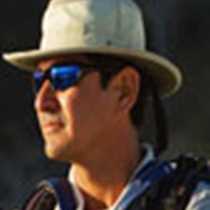Isabela & Fernandina Islands
What a wonderful day we had today!
Early in the morning we found ourselves navigating in the northern hemisphere towards the western part of the archipelago; Isabela and Fernandina Islands were our next destinations. An optional wake up call was offered by our Expedition Leader, Lynn Fowler and we were soon rewarded by a deep ocean leviathan. A Bryde’s whale and her calf swam elusively around us as the sun rose over Wolf and Ecuador volcanoes.
Our navigation continued and we had breakfast while we approached the equator line; meanwhile our captain Pablo Garces shut down the engines as we were about to reach 0 degrees latitude. We gathered in the bridge and “crossed” into the southern hemisphere together. For some of us this was our first time crossing the “line” at sea, and life may never be the same.
We reached Punta Vicente Roca on Isabela Island for our panga ride which allowed us to view a variety of wildlife that was revealed as we slowly explored the shore line. We observed Galápagos penguins, flightless cormorants, sea lions, and sea turtles and all of them, against a majestic volcanic backdrop.
Back onboard we readied ourselves for a deep water snorkel outing and were immediately surrounded by an impressive number of Pacific green turtles, sea lions, many species of fish and even birds “flying” underwater – the penguins.
During lunch the Captain repositioned the National Geographic Islander towards Fernandina while Naturalist Emma Ridley presented an excellent talk about Charles Darwin and his theory of natural selection.
Fernandina Island is one of the few pristine tropical places on the planet; no animals have been introduced to this island. The ecology is so unique it becomes a site almost impossible to describe: brand new lava flows upon which marine iguanas pile up in huge numbers, flightless cormorants with a dark and mysterious look, the ever present sea lions, bright red crabs, rough lava shoreline, gentle breeze, co-existence but also isolation. An afternoon walk in the golden light of the setting sun did not fail to move each and everyone of our guests.
The sun sets, an orange ball of fire, and so we return to the National Geographic Islander for our recap of the day. Soon after dinner, we climbed to the skydeck, to witness the stars of both the northern and southern hemispheres without any light pollution. We were surrounded by calm waters on a peaceful night, and Naturalist Antonio Adrian shared with us the wonders of this celestial sphere. We are at the peak of our expedition and we have bonded through coexistence and love for this wonderful place called the Galápagos, a place unrivaled and unique on our planet Earth.
What a wonderful day we had today!
Early in the morning we found ourselves navigating in the northern hemisphere towards the western part of the archipelago; Isabela and Fernandina Islands were our next destinations. An optional wake up call was offered by our Expedition Leader, Lynn Fowler and we were soon rewarded by a deep ocean leviathan. A Bryde’s whale and her calf swam elusively around us as the sun rose over Wolf and Ecuador volcanoes.
Our navigation continued and we had breakfast while we approached the equator line; meanwhile our captain Pablo Garces shut down the engines as we were about to reach 0 degrees latitude. We gathered in the bridge and “crossed” into the southern hemisphere together. For some of us this was our first time crossing the “line” at sea, and life may never be the same.
We reached Punta Vicente Roca on Isabela Island for our panga ride which allowed us to view a variety of wildlife that was revealed as we slowly explored the shore line. We observed Galápagos penguins, flightless cormorants, sea lions, and sea turtles and all of them, against a majestic volcanic backdrop.
Back onboard we readied ourselves for a deep water snorkel outing and were immediately surrounded by an impressive number of Pacific green turtles, sea lions, many species of fish and even birds “flying” underwater – the penguins.
During lunch the Captain repositioned the National Geographic Islander towards Fernandina while Naturalist Emma Ridley presented an excellent talk about Charles Darwin and his theory of natural selection.
Fernandina Island is one of the few pristine tropical places on the planet; no animals have been introduced to this island. The ecology is so unique it becomes a site almost impossible to describe: brand new lava flows upon which marine iguanas pile up in huge numbers, flightless cormorants with a dark and mysterious look, the ever present sea lions, bright red crabs, rough lava shoreline, gentle breeze, co-existence but also isolation. An afternoon walk in the golden light of the setting sun did not fail to move each and everyone of our guests.
The sun sets, an orange ball of fire, and so we return to the National Geographic Islander for our recap of the day. Soon after dinner, we climbed to the skydeck, to witness the stars of both the northern and southern hemispheres without any light pollution. We were surrounded by calm waters on a peaceful night, and Naturalist Antonio Adrian shared with us the wonders of this celestial sphere. We are at the peak of our expedition and we have bonded through coexistence and love for this wonderful place called the Galápagos, a place unrivaled and unique on our planet Earth.




